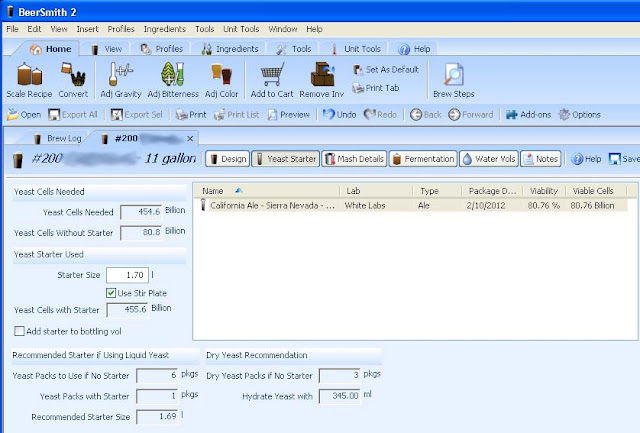Yeast Starter - the Growing Process
Posted: Mon Feb 27, 2012 9:41 pm
1 pack (Wyeast 100 ml or White Labs 35 ml liquid yeast packages) yeast equals about 96 billion cells by the time you get or less.
96 billion cells will double in 1 liter of wort at 1.040 SG without aerating the wort which equals about 192 billion cells.
If you take the original 96 billion cells and add it to the same wort recipe as above but use a stir plate, you will get about 397.1 billion cells.
The interesting thing is that increasing your volume of starter wort doesn't increase the yeast that much.
With a 2 liter starter, you get 538 billion cells which is a delta of only 141 billion added cells added.
If your increase your starter to 3 liters you get 576 billion cells which is a delta of only 178 billion cells added.
So, it your saved about 15 ml slurry of your original 397 billion cells or about 250 ml of (1/4) of the original liter with the yeast in suspension and started over with 96 billion, you would end up with 794 billion cells with just 2 liters of wort. You have saved 1/3 the cost of the DME with just a few more hours on the stir plate. (2 liters of wort versus 3 liters of wort). That is a delta of 218 billion cells of 2 liters of wort compared to 3 liters of wort.
Now let us assume that you are brewing a 6 gallon batch of ale at 1.047 SG (198 billion cell needed). You really only need about ½ liter of wort for a starter on a stir plate with one package of yeast. So do a 1 liter starter (397 billion cells) and pour off 500 ml of yeast in suspension and save it in a sanitized jar and put it the refrigerator.. You have your next starter.
Hope that I did my math right and you can understand the steps.
By the way, you do not need the great tornado vortex that see in the videos of people stirring water to grow yeast. All you need is a slight vortex on top of the spinning wort, the O2 absorption occurs on the total surface area of the wort, so don’t fill your flask too full. Where power of the stir plate comes into play or sometimes more importantly getting the stir bar to connect is that as yeast multiply, the viscosity increases.
Have fun growing yeast and save yourself some money along the way.
96 billion cells will double in 1 liter of wort at 1.040 SG without aerating the wort which equals about 192 billion cells.
If you take the original 96 billion cells and add it to the same wort recipe as above but use a stir plate, you will get about 397.1 billion cells.
The interesting thing is that increasing your volume of starter wort doesn't increase the yeast that much.
With a 2 liter starter, you get 538 billion cells which is a delta of only 141 billion added cells added.
If your increase your starter to 3 liters you get 576 billion cells which is a delta of only 178 billion cells added.
So, it your saved about 15 ml slurry of your original 397 billion cells or about 250 ml of (1/4) of the original liter with the yeast in suspension and started over with 96 billion, you would end up with 794 billion cells with just 2 liters of wort. You have saved 1/3 the cost of the DME with just a few more hours on the stir plate. (2 liters of wort versus 3 liters of wort). That is a delta of 218 billion cells of 2 liters of wort compared to 3 liters of wort.
Now let us assume that you are brewing a 6 gallon batch of ale at 1.047 SG (198 billion cell needed). You really only need about ½ liter of wort for a starter on a stir plate with one package of yeast. So do a 1 liter starter (397 billion cells) and pour off 500 ml of yeast in suspension and save it in a sanitized jar and put it the refrigerator.. You have your next starter.
Hope that I did my math right and you can understand the steps.
By the way, you do not need the great tornado vortex that see in the videos of people stirring water to grow yeast. All you need is a slight vortex on top of the spinning wort, the O2 absorption occurs on the total surface area of the wort, so don’t fill your flask too full. Where power of the stir plate comes into play or sometimes more importantly getting the stir bar to connect is that as yeast multiply, the viscosity increases.
Have fun growing yeast and save yourself some money along the way.
